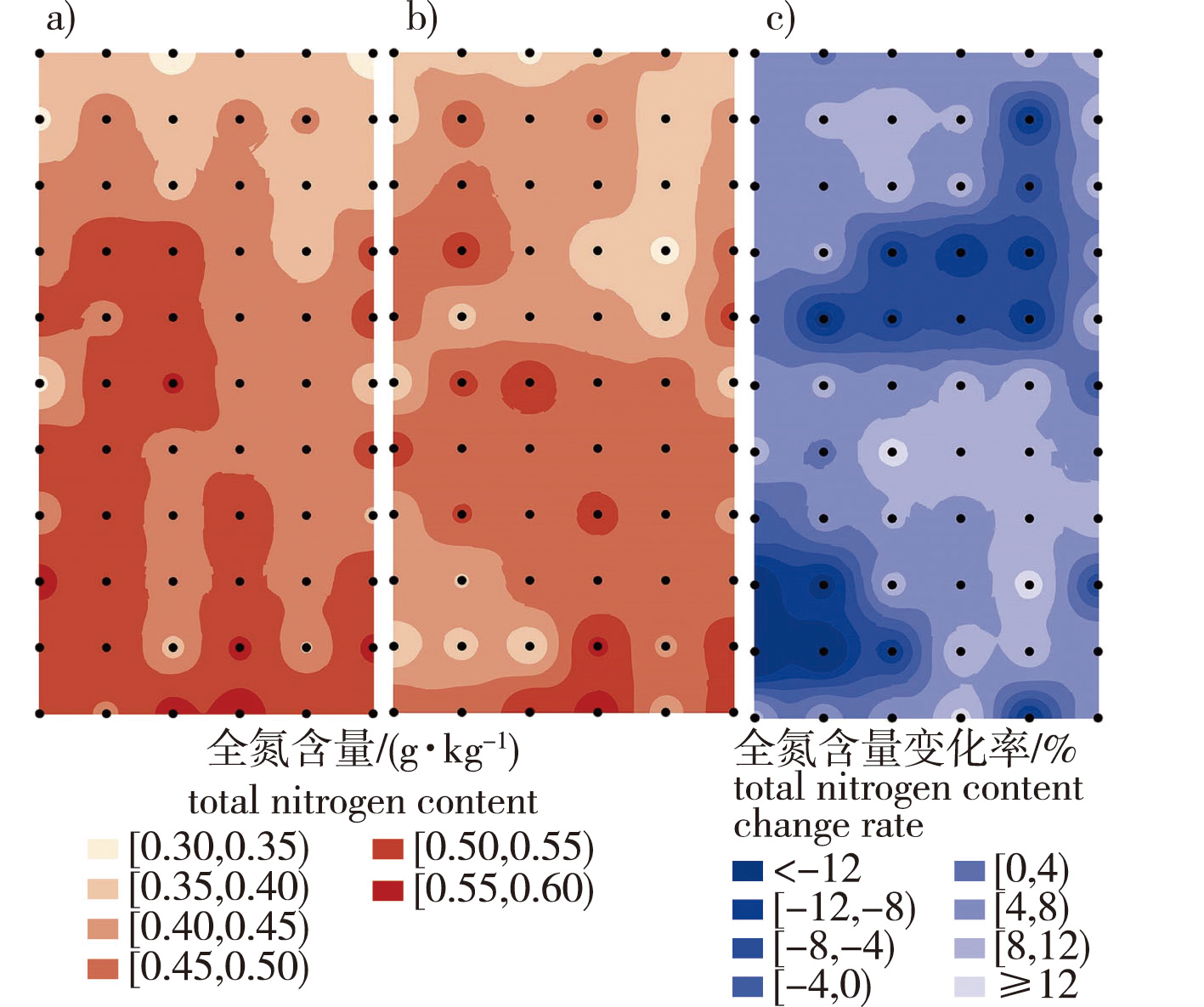 PDF(2857 KB)
PDF(2857 KB)


Early effects of fire on soil nitrogen content and form in Larix gmelinii forests
ZUO Zhuang, ZHANG Yun, CUI Xiaoyang
JOURNAL OF NANJING FORESTRY UNIVERSITY ›› 2024, Vol. 48 ›› Issue (1) : 147-154.
 PDF(2857 KB)
PDF(2857 KB)
 PDF(2857 KB)
PDF(2857 KB)
Early effects of fire on soil nitrogen content and form in Larix gmelinii forests
【Objective】This paper elaborated upon the changes in soil total nitrogen and mineral nitrogen ($\mathrm{NH}_{4}{ }^{+}$-N and $\mathrm{NO}_{3}{ }^{-}$-N) contents, the nitrogen form characteristics and their spatial patterns in lightly, moderately and severely burned areas, which comprehensively reflected the characteristics of soil nitrogen nutrition habitats during the early restoration period of burned forest areas in the Greater khingan Mountains. This study aimed to provide a reference for the renovation and ecological restoration of burned coniferous forests in cold temperate zones.【Method】In the Ledum palustre-Rhododendron simsii-Larix gmelinii forest, fixed sample plots were set up with the grid method, and the intensity of the forest fire was controlled by artificial ignition. Soil samples were collected by auger boring before and one year after burning. The soil total nitrogen, $\mathrm{NH}_{4}{ }^{+}$-N and $\mathrm{NO}_{3}{ }^{-}$-N contents were measured, the change rate of each index and the ratio of mineral nitrogen forms were calculated, and the spatial patterns were drawn.【Result】A year after the burning: (1) Soil total nitrogen content changed, and its change rate was divided into two stages. In the lightly and moderately burned areas, soil total nitrogen content increased. Its spatial pattern was not obviously correlated with the fire intensity spatial pattern, but its change rate spatial pattern was. In the severely burned area, the soil total nitrogen content decreased. The spatial and change rate spatial patterns were both negatively correlated with the fire intensity spatial pattern. (2) Soil $\mathrm{NH}_{4}{ }^{+}$-N content increased in all burned areas; its spatial and change rate spatial patterns were not obviously correlated with the fire intensity spatial pattern. (3) Soil $\mathrm{NO}_{3}{ }^{-}$-N content increased significantly; its spatial and change rate spatial patterns were both positively correlated with the fire intensity spatial pattern. (4) The soil nitrogen form showed evident $\mathrm{NH}_{4}{ }^{+}$-N dominance, but its dominance (the content ratio of $\mathrm{NH}_{4}{ }^{+}$-N to $\mathrm{NO}_{3}{ }^{-}$-N) was reduced. The ratio spatial pattern and change rate spatial pattern were negatively correlated with the spatial pattern of fire intensity. 【Conclusion】During the early restoration period of burned areas in the Larix gmelinii forest, the change in soil nitrogen nutrition habitat did not constitute an obstacle to the restoration of native vegetation types; however, the decline of soil total nitrogen in the severely burned area may bring about the fall-off in nitrogen supply capacity in the long-term.

Larix gmelinii / forest fire / soil nitrogen / spatial pattern
| [1] |
|
| [2] |
谢丹妮, 仰东星, 段雷. 森林生态系统对大气氮沉降降低的响应[J]. 环境科学, 2022:1-19.2023, 44(5):2681-2693.
|
| [3] |
张韫, 于悦, 崔晓阳. 试验林火干扰下大兴安岭北部落叶松林土壤含水率的时空变化[J]. 北京林业大学学报, 2020, 42(8): 94-101.
|
| [4] |
孔健健, 杨健. 火烧对中国东北部兴安落叶松林土壤性质和营养元素有效性的影响[J]. 生态学杂志, 2013, 32(11):2837-2843.
|
| [5] |
王梓璇, 周梅, 赵鹏武, 等. 火干扰恢复初期土壤呼吸及其组分与土壤温湿度关系[J]. 东北林业大学学报, 2021, 49(8):78-83,89.
|
| [6] |
杨玉盛, 李振问, 杨伦增. 林火对森林生态系统氮素循环影响(综述)[J]. 福建林学院学报, 1992, 12(1):105-111.
|
| [7] |
姚余君, 刘菲, 胡海清, 等. 火烧对胡桃楸人工林土壤化学性质的影响[J]. 东北林业大学学报, 2008, 36(7):34-36.
|
| [8] |
陶玉柱. 火干扰对塔河白桦落叶松林土壤化学性质的短期影响[J]. 辽宁林业科技, 2016(3):1-4,18.
|
| [9] |
|
| [10] |
张琳, 王益, 舒梦, 等. 火烧对黄土高原草地土壤氮素净矿化速率和净硝化速率的影响[J]. 南京农业大学学报, 2017, 40(6):1051-1057.
|
| [11] |
刘瑞斌, 李莉, 陈鹏东, 等. 森林火灾对烟台蓁山次生林土壤性质的影响[J]. 生态环境学报, 2016, 25(8):1300-1305.
|
| [12] |
王丽, 嶋一徹. 山地林火烧迹地土壤养分的动态变化[J]. 水土保持通报, 2008, 28(1):81-85.
|
| [13] |
|
| [14] |
向泽宇, 陈瑞芳, 蒋忠荣, 等. 川西北高寒草甸对火烧干扰的短期响应[J]. 草业科学, 2014, 31(11):2034-2041.
|
| [15] |
|
| [16] |
|
| [17] |
|
| [18] |
|
| [19] |
|
| [20] |
|
| [21] |
|
| [22] |
|
| [23] |
|
| [24] |
谷会岩, 金屿淞, 张芸慧, 等. 林火对大兴安岭偃松—兴安落叶松林土壤养分的影响[J]. 北京林业大学学报, 2016, 38(7):48-54.
|
| [25] |
孙明学, 贾炜玮, 吴瑶. 大兴安岭北部地区林火对土壤化学性质的影响[J]. 东北林业大学学报, 2009, 37(5):33-35.
|
| [26] |
魏云敏, 袁强. 不同强度火烧对兴安落叶松林土壤铵态氮的影响[J]. 林业科技, 2015, 40(3):18-19.
|
| [27] |
孔健健, 杨健. 林火对大兴安岭落叶松林土壤性质的短期与长期影响[J]. 生态学杂志, 2014, 33(6):1445-1450.
|
| [28] |
|
| [29] |
中国林业科学研究院林业研究所. 森林土壤全氮的测定: LY/T 1228—1999[S]. 北京: 中国标准出版社,1999.
Research Institute of Forestry, Chinese Academy of Forestry. Determination of total nitrogen in forest soil:LY/T 1228—1999[S]. Beijing: Standards Press of China, 1999.
|
| [30] |
|
| [31] |
张韫, 李传波, 崔晓阳. 大兴安岭北部试验林火干扰下土壤密度的时空变化[J]. 北京林业大学学报, 2018, 40(6):48-54.
|
| [32] |
|
| [33] |
|
| [34] |
|
| [35] |
|
| [36] |
|
| [37] |
罗斯生, 罗碧珍, 魏书精, 等. 森林火灾对马尾松次生林土壤理化性质的影响[J]. 生态环境学报, 2020, 29(11):2141-2152.
|
| [38] |
张蕊, 郭亚芬, 崔晓阳. 氮素形态对兴安落叶松幼苗的营养效应[J]. 东北林业大学学报, 2017, 45(5):16-19.
|
/
| 〈 |
|
〉 |